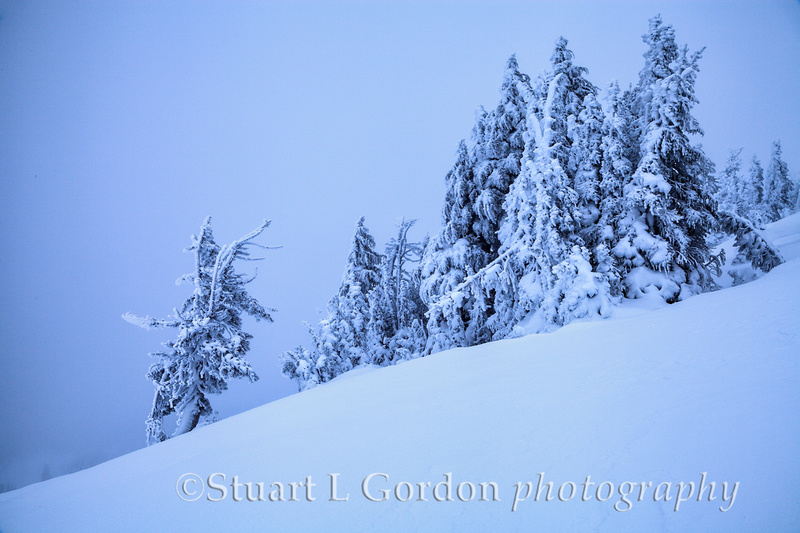Chasing Rainbows
When I first stepped outside the cabin I was staying in that morning, the sky was dreary gray and it was drizzling. I questioned whether it might be wiser to go back to bed and catch up on my sleep. But I forced myself out into the wet, cold autumn air because I had been through mornings like this before and knew that you just never know what to expect from the weather. My intent was to find autumn foliage to photograph along the banks of Suttle Lake, Oregon. As I was looking for subject matter, the sun began to break through the cloud cover — the remains of an overnight rainstorm. The sunrise bathed the west and north bank of the lake with a beautiful warm golden light. I already had my 16-35 mm lens on my camera and began to look for some foreground driftwood or other options for a wide-angle shot across the lake. I left my heavy camera bag on the ground and wandered along the lakefront with my camera on a tripod. I had gone about 75 yards when I noticed the rainbow forming in a graceful arch over the lake. I realized with a moan that my 16-35 mm lens wasn’t going to cut it. Not enough of an impact. I needed something with more reach, like my 24-105 mm, which was in my bag almost a football field away. I knew how quickly rainbows fade, so I tried to prepare myself for an emotional letdown by telling myself that I wouldn’t have the time to get my other lens before this beautiful scene evaporated, so why bother trying. Despite that bit of negativism, I bolted for my camera bag anyway. I was careful to trot rather than run because the last time I ran full bore I pulled a hamstring playing soccer with my son. I grabbed my other lens and a polarizer filter and ran back to my camera and tripod all the while expecting the rainbow to disappear before my eyes. I was thrilled when I finished switching my lens and screwing on the polarizer to find that rather than having faded, the rainbow had gotten even more distinct. I turned the polarizer one way and the rainbow evaporated. I turned it the opposite way and the prismatic effect intensified, with the rainbow’s colors getting richer and darker. Perfect. I was able to fire off three shots before the rainbow lost its pop. Like I said at the start, you never know what to expect from the weather, so don’t scrap a photography outing just because things initially look bleak. Have some patience and you might just be rewarded with an awesome image.
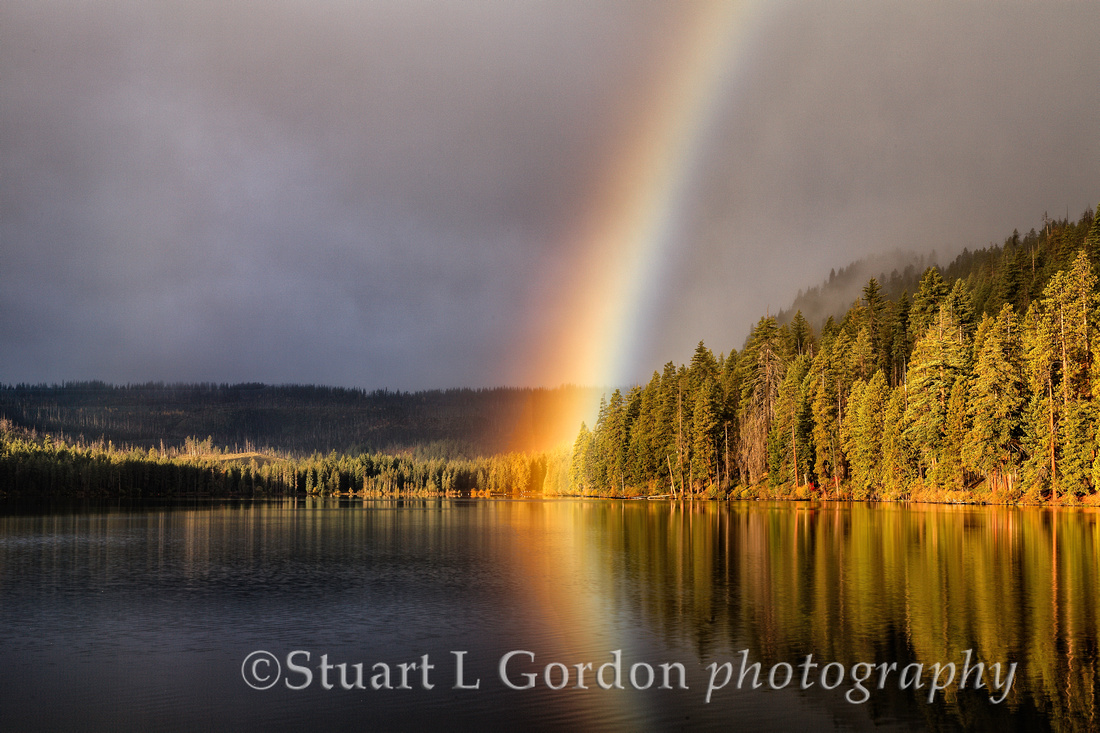

The Photos We Almost Didn’t Take
I can’t tell you how many times I’ve told myself it was okay to pass up a shot when in my heart I knew I should stop, get out my camera and tripod and snap away at a scene. When I do fail to stop, I usually end up looking longingly at the fast-receding scene in my car’s rearview mirror. I might pass up a landscape photo opportunity because: 1) I believe I already have taken too many photos on this outing; 2) the weather looks pretty crummy, or is bone-chilling cold; 3) the light isn’t dramatic or interesting.
As I watch the scene in my rearview mirror get smaller and smaller, I might hear an inner voice chime in: look, the weather is clearing up; OMG, the light is breaking through the clouds; or, there’s no such thing as taking too many pictures.
I look back on my collection of images and definitely can see there are some nearly aborted images that became my favorites. Thankfully, I tell myself, I didn’t listen to that naysayer inside my head telling me to “Keep driving and don’t look back!”
The images in this post illustrate this point, perfectly. They came close to being passed up. Fortunately, I lingered at the location long enough to see conditions change until the true beauty of the scene revealed itself. Usually, it was light that transformed the scene. Which makes me thankful to be out on location during the margins of the day — sunset and sunrise — when magical things really do happen before our very eyes.
The shot of the Three Sisters I took while out driving around one morning before dawn in anticipation of the sunrise. At first I passed this location thinking it was too familiar and easy, being that it was right off the road connecting my hometown of Bend and nearby Sisters, Oregon. But then I thought to myself, "It's not how far you hike, but rather than quality of light that makes a beautiful image." So I made the choice to stop, park and locate a good spot off the side of the road and wait for the sunrise. Glad I did.
The other image is of sunrise on Easter morning at Pine Mountain in the high desert east of Bend. I had gone out there early to get a shot of sunrise light on one lone tree that I had seen while scouting the area a month earlier. I got the shot I had envisioned, but when I walked around exploring a little more on my way back to my car, I spotted this scene and wondered what it might look like when the sun came up over the horizon. I started telling myself that the shot I had come after was already in the can, and was ready to call it quits because my fingers were numb from the cold. But something nagged at me to wait and see what materialized. Then I told myself that it would be an impossible shot because the contrast looking into the sun would be too great for my camera to capture. As I was about to leave the idea of using the outcropping of rock to block the sun itself popped into my head, so I stayed. Again, glad I did.
Three Sisters in Sunrise Light


High Desert Sunrise
Love The Light You're With
Photographers are always looking for the "right" light to enhance their subjects, whether it be a portrait, landscape or product shoot. In landscape photography, for instance, we're always looking to the "golden" light around the time of sunrise and sunset to give our images that "wow factor." Sometimes, however, due to constraint of time, we have to learn to make the best use of the light we are given. This was the case when I recently visited Valley of Fire State Park in the Mojave Desert north of Las Vegas, Nevada.
I knew I had not even two days to spend in this geological wonder and photographic playground. I was interpreting that to mean one sunset and one sunrise opportunity to catch the really great light — that is if the weather cooperated. Well, the weather did cooperate, and I got my morning and sunset shots. But those are such fleeting moments that it's almost impossible to get to more than one or two locations illuminated by the light of sunrise and sunset before it vanishes. So what would I do with myself the rest of the day, I wondered. I figured I'd spend the rest of the day scouting out sunrise and sunset locations. Well, I did that, but I found myself getting the best shots in the middle of day, which is when all the experts say you might as well go find a hammock and catch up on your sleep because the light will be too bright and contrasty for making fine images.
This is where the morale of my story makes its entry. If you spend enough time in a place using "photographer's eyes," you might just find how to use the available light to your advantage. Using photographer's eyes means not just looking, but really seeing and connecting with the landscape. The thing that I noticed about the Valley of Fire as I became familiar with it by traveling around its interior roads, is that the bright light of mid-day actually enhances the vividness of the colors in the Aztec and Navajo sandstone formations. Bright light really brought out some great things in the landscape, like the bands of yellow, rust, red, purple, gold and lavender colors. The one caveat was that it only seemed to work if you pointed the camera at the landscape with your back to the sun. This is called frontal lighting, and it enabled me to get some very compelling images without the heavy contrast you usually get from deep shadows at mid-day with side-lighting.
First, I was glad to be able to get "to know" the Valley of Fire well enough to recognize this about it. Second, I was pleased to see that my years of training in the Japanese martial art of aikido still prepares me in many ways in life to go with the flow of events.
As therapist and Holocaust survivor Victor Frankl once observed:
"When you're faced with a situation that you cannot possibly change, your challenge is to change yourself."

 "Ring of Fire"
"Ring of Fire"
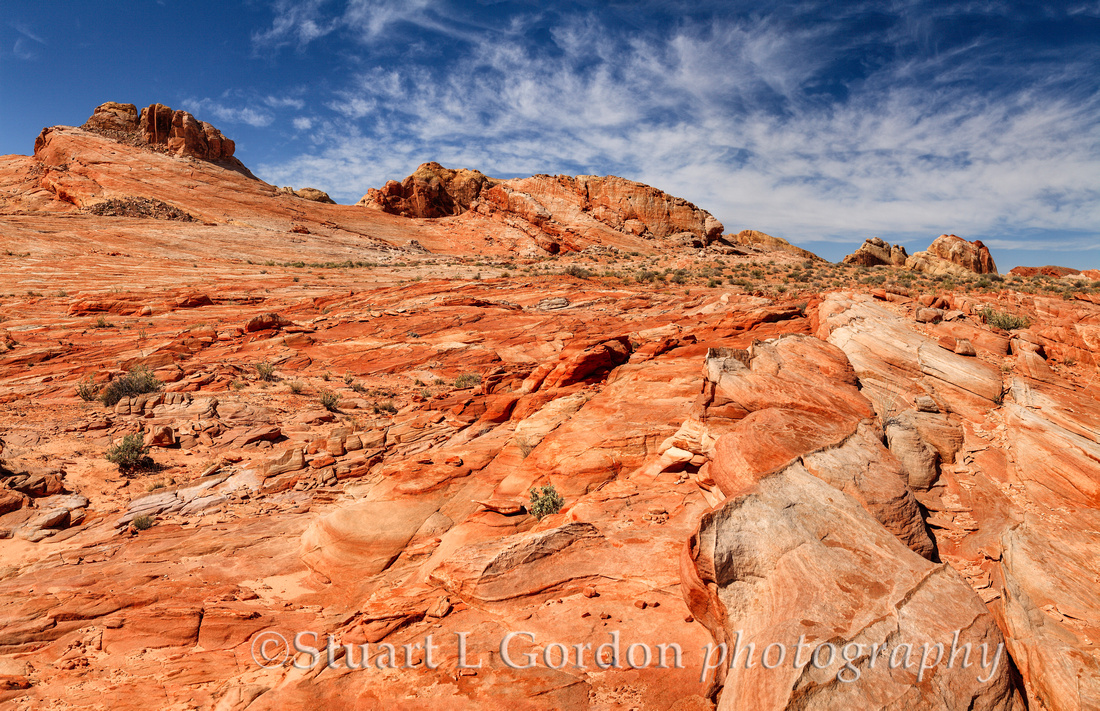
 "Confluence of Land & Sky"
"Confluence of Land & Sky"
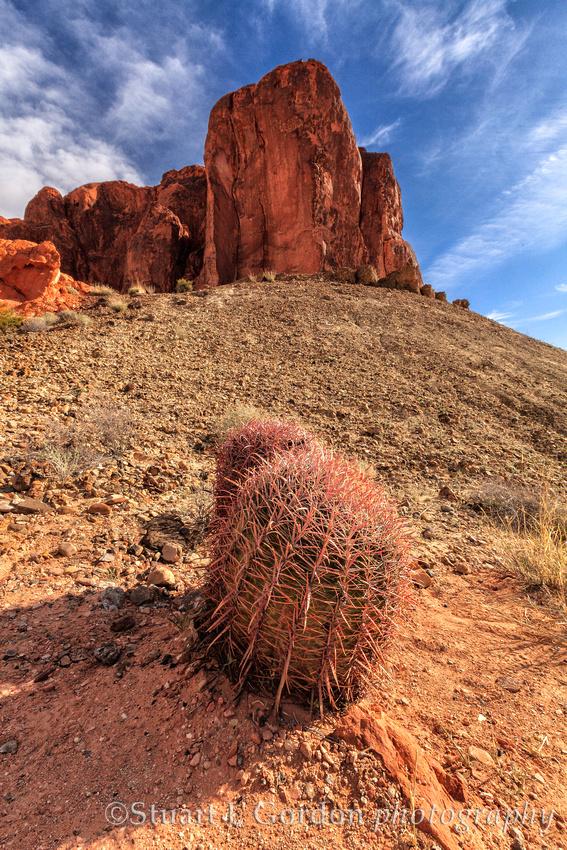

"Cactus & Monolith"
The Monet Factor
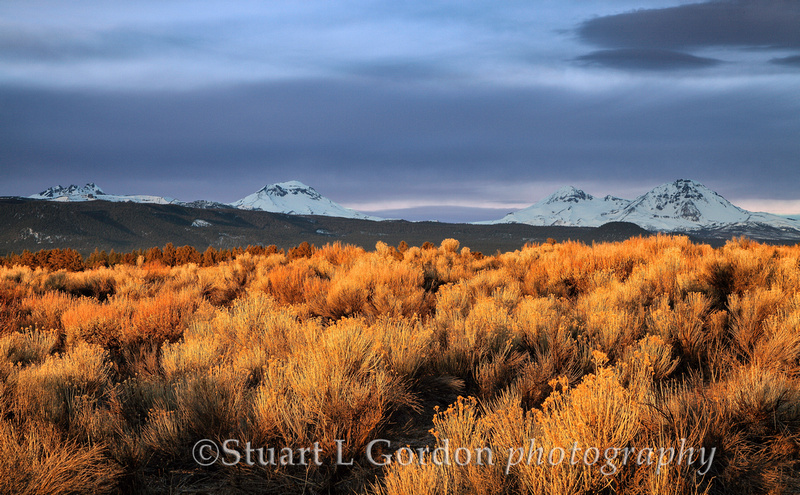

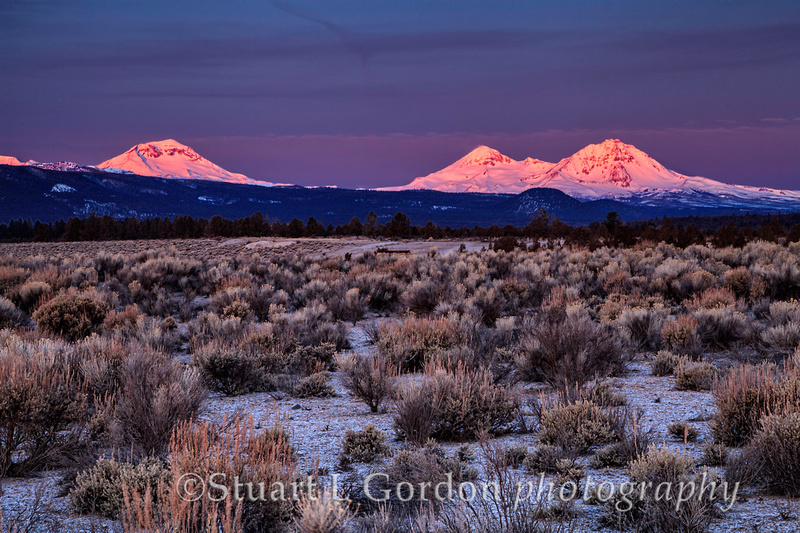

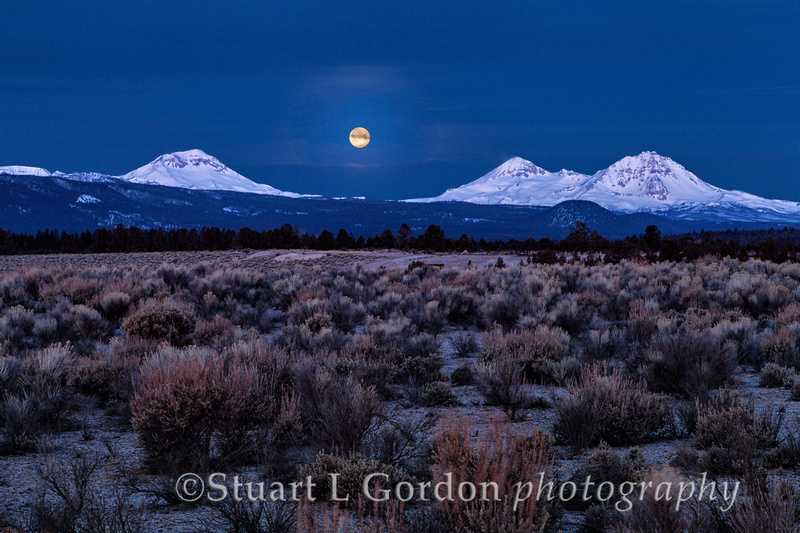

I'm assuming I don't have to tell you that the above three images were all taken at the same location, with the same lens and within minutes of each other. I might have changed the focal length of the lens ever so slightly. These images are pretty much identical, and yet they look so different. In fact, a casual observer might at first glance think they were taken at different locations and were completely different scenes.
Truth is, these images demonstrate that with very little change in where you plant your feet, you can obtain some dramatic changes just by waiting patiently for the light or atmospheric conditions to change. During the rapidly changing conditions bracketing sunset and sunrise, you won't have to wait long. The above images, for example, were taken within a 20-minute period.
I was inspired to make a systematic study of the changes that light and weather can create on the landscape after reading about French Impressionist artist Claude Monet. Monet often created "sequences" of canvases all of the same scene and same location as a result of his fascination with ephemeral light and weather conditions. In fact, Monet made light and atmospheric conditions the primary focal point of his paintings. Secondary was the subject of the painting — it could be haystacks, the facade of a cathedral, a stand of poplars, a seascape, or his beloved water-lilly pond and Japanese bridge in his own garden in Giverny. It didn't matter much because it was all about the light and ambient conditions. As Monet observed,
"For me, a landscape does not exist in its own right, since its appearance changes at every moment; but its surroundings bring it to life, through the air and the light, which continually vary..."
And so Monet would paint the same scene over and over again — sometimes dozens of canvases of the same scene — capturing the ephemeral light, realizing that each scene was a different and unrepeatable moment when light, subject matter and weather conditions came together to create an extraordinary scene.
The same certainly applies to photography, an art which by its very nature depends on light for its very existence. If you study the light, you can anticipate it. And if you can anticipate it, you can prepare to capture it. And if you capture it, you know that you have preserved a moment that will never happen again, not exactly as you saw it, no matter how long you live nor how many sunsets and sunrises take place.
And you might even want to think about applying the same philosophy to every moment of your life — treating it as unique and unrepeatable.
Winter Solstice
After a two-hour pre-dawn snowshoe up Tumalo Mountain this morning (Friday, Dec. 7 with a friend), we found everything socked in and snow falling lightly. With any visibility, you'd be seeing two gorgeous snow-topped mountains in the background (South Sister and Broken Top), but not on this day. I was tired and disappointed. But I remembered we are, after all, approaching the Winter Solstice. So here's my photo celebrating the approach of the long winter in Central Oregon.